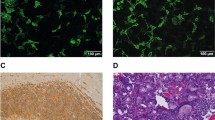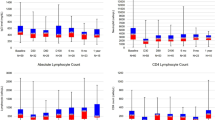Abstract
Listeriosis is uncommon in recipients of allogeneic blood, marrow and organ transplantation. Six patients with systemic Listeria monocytogenes infection during 1985–1997 at Bone Marrow Transplantation Service, Memorial Sloan-Kettering Cancer Center are described. In two male and four female patients, the median duration from transplantation to isolation of L. monocytogenes was 62.5 (range 29 to 821) days. Among five allogeneic marrow transplant recipients, four (80%) received HLA antigen matched, T cell-depleted grafts from three unrelated and a single related donor. One patient underwent mismatched-related marrow graft transplant. Cord stem cell transplantation was performed in a single patient. Two required therapy for graft-versus-host disease (GVHD). The 13 year incidence of systemic Listeria infections was 0.47 percent. All six presented with fever (>39°C), and L. monocytogenes bloodstream invasion. Mental status changes and meningioencephalitis were observed in two (33.3%). A concurrent primary opportunistic infection was present in five individuals (83.3%), and four (80%) were being treated for acute human cytomegalovirus (HCMV) viremia. Sixty-six percent responded to therapy and two died from unrelated, non-listeric causes. Systemic listeriosis was uncommon in our high-risk allogeneic blood and marrow transplantation population, and response to therapy with parenteral ampicillin and gentamicin was excellent. The association between primary HCMV reactivation and subsequent listeric infection emphasizes the significance of HCMV-related dysfunction in hosts’ cellular immune responses, especially in the setting of allogeneic transplantation.
This is a preview of subscription content, access via your institution
Access options
Subscribe to this journal
Receive 12 print issues and online access
$259.00 per year
only $21.58 per issue
Buy this article
- Purchase on Springer Link
- Instant access to full article PDF
Prices may be subject to local taxes which are calculated during checkout
Similar content being viewed by others
References
Williamson EC, Millar MR, Steward CG et al. Infections in adults undergoing unrelated donor bone marrow transplantation Br J Haematol 1999 104: 560 568
Safdar A, Armstrong D . Infectious morbidity in critically ill patients with cancer Crit Care Clin 2001 17: 531 570
Chang J, Powles R, Mehta J et al. Listeriosis in bone marrow transplant recipients: incidence, clinical features, and treatment Clin Infect Dis 1995 21: 1289 1290
Mehta J, Powles R, Singhal S et al. Antimicrobial prophylaxis to prevent opportunistic infections in patients with chronic lymphocytic leukemia after allogeneic blood or marrow transplantation Leuk Lymphoma 1997 26: 83 88
Mauleman N, Debruyne JM, Jacquy C, Bron D . Incidence of CMV infection and CMV disease in allogeneic transplanted patients. From no prophylaxis to preemptive treatment Exp Hematol 2000 28: 1501
Boiron JM, Lerner D, Pigneux A et al. Allogeneic transplantation for patients with advanced acute leukemia: a single center retrospective study of 92 patients Leuk Lymphoma 2001 41: 285 296
Bilgrami S, Almeida GD, Quinn JJ et al. Pancytopenia in allogeneic marrow transplant recipients: role of cytomegalovirus Br J Haematol 1994 87: 357 362
Sparrelid E, Emanuel D, Fehniger T et al. Interstitial pneumonitis in bone marrow transplant recipients is associated with local production of TH2-type cytokines and lack of T cell-mediated cytotoxicity Transplantation 1997 63: 1782 1789
Rowbottom AW, Lepper MW, Sharpstone D et al. Cytomegalovirus (CMV) infection in AIDS patients is associated with a CD3 receptor-mediated T cell hyporesponsiveness Clin Exp Immunol 1998 111: 559 563
Broers AE, van Der Holt R, van Esser JW et al. Increased transplant-related morbidity and mortality in CMV-seropositive patients despite highly effective prevention of CMV disease after allogeneic T-cell-depleted stem cell transplantation Blood 2000 95: 2240 2245
Small TN, Papadopoulos EB, Boulad F et al. Comparison of immune reconstitution after unrelated and related T-cell-depleted bone marrow transplantation: effect of patient age and donor leukocyte infusion Blood 1999 93: 467 480
Papadopoulos EB, Carabasi MH, Castro-Malaspina H et al. T-cell-depleted allogeneic bone marrow transplantation as postremission therapy for acute myelogenous leukemia: freedom from relapse in the absence of graft-versus-host disease Blood 1998 91: 1083 1090
Mackinnon S, Barnett L, Heller G, O'Reilly RJ . Minimal residual disease is more common in patients who have mixed T-cell chimerism after bone marrow transplantation for chronic myelogenous leukemia Blood 1994 83: 3409 3416
Kernan NA, Schroeder ML, Ciavarella D et al. Umbilical cord blood infusion in a patient for correction of Wiskott–Aldrich syndrome Blood Cells 1994 20: 245 248
Moellering RC Jr, Medoff G, Leech I et al. Antibiotic synergism against Listeria monocytogenes Antimicrob Agents Chemother 1972 1: 30 34
Donnelly JP . Bacterial complications of transplantation: diagnosis and treatment J Antimicrob Chemother 1995 36: S59 72
Patel R, Paya CV . Infections in solid-organ transplant recipients Clin Microbiol Rev 1997 10: 86 124
Snydman DR . Epidemiology of infections after solid-organ transplantation Clin Infect Dis 2001 33(Suppl 1): 5 8
Safdar A, Armstrong D . Infections in patients with neoplastic diseases In: Shoemaker WC, Grenvik M, Ayers SM, Holbrook PR (eds) Textbook of Critical Care, 4th edn Saunders: Philadelphia 2000 pp 715 726
Martino R, Lopez R, Pericas R et al. Listeriosis in bone marrow transplant recipients Clin Infect Dis 1996 23: 419 420
Long SG, Leyland MJ, Milligan DW . Listeria meningitis after bone marrow transplantation Bone Marrow Transplant 1993 12: 537 539
Schuchat A, Deaver KA, Wenger JD et al. Role of foods in sporadic listerosis. I. Case-control study of dietary risk factors JAMA 1992 267: 2041 2045
Jurado RL, Farley MM, Pereira E et al. Increased risk of meningitis and bacteremia due to Listeria monocytogenes in patients with human immunodeficiency virus infection Clin Infect Dis 1993 17: 224 227
Spitzer PG, Hammer SM, Karchmer AW . Treatment of Listeria monocytogenes infection with trimethoprim–sulfamethoxazole: case report and review of the literature Review Infect Dis 1986 8: 427 430
Tolkoff-Rubin NE, Rubin RH . Opportunistic fungal and bacterial infection in the renal transplant recipient J Am Soc Nephrol 1992 2: (Suppl. 1) 264 269
Limaye AP, Perkins JD, Kowdley KV . Listeria infection after liver transplantation: report of a case and review of the literature Am J Gastroenterol 1998 93: 1942 1944
Nickol AD, Bonventre PF . Anomalous high native resistance of athymic mice to bacterial pathogens Infection Immunity 1977 18: 636 645
Roesler J, Grottrup E, Baccarini M, Lohmann-Mattes ML . Efficient natural defense mechanisms against Listeria monocytogenes in T and B cell-deficient allogeneic bone marrow radiation chimeras. Preactivated macrophages are the main effector cells in an early phase after bone marrow transfer J Immunol 1989 143: 1710 1715
Roesler J, Baccarini M, Vogt B, Lohmann-Matthes ML . Macrophage function in murine allogeneic bone marrow radiation chimeras in the early phase after transplantation J Leukocyte Biol 1989 46: 134 143
Acknowledgements
Portions of the study were presented at the 9th International Congress on Infectious Diseases, The International Society for Infectious Diseases, April 10–13, 2000 in Buenos Aires, Argentina, and 39th Annual Meeting of The Infectious Diseases Society of America (IDSA), October 25–28, 2001 in San Francisco, USA.
Author information
Authors and Affiliations
Rights and permissions
About this article
Cite this article
Safdar, A., Papadopoulous, E. & Armstrong, D. Listeriosis in recipients of allogeneic blood and marrow transplantation: thirteen year review of disease characteristics, treatment outcomes and a new association with human cytomegalovirus infection. Bone Marrow Transplant 29, 913–916 (2002). https://doi.org/10.1038/sj.bmt.1703562
Received:
Accepted:
Published:
Issue Date:
DOI: https://doi.org/10.1038/sj.bmt.1703562
Keywords
This article is cited by
-
Opportunistic Infections of the Central Nervous System in the Transplant Patient
Current Neurology and Neuroscience Reports (2013)



